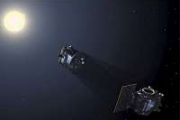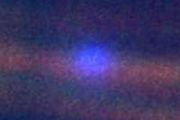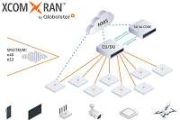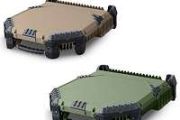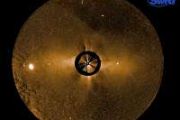
Copernical Team
NASA's role in agriculture
 Everybody needs to eat. Food is a basic necessity, and it is at the heart of every human culture and our sense of home. It also represents one of our most important connections to Earth. Crops and animal products, whether gathered from the ocean or the land, raised on farms big and small, across vast fields or in our backyards and urban communities, draw on sunlight, water and soil to grow and t
Everybody needs to eat. Food is a basic necessity, and it is at the heart of every human culture and our sense of home. It also represents one of our most important connections to Earth. Crops and animal products, whether gathered from the ocean or the land, raised on farms big and small, across vast fields or in our backyards and urban communities, draw on sunlight, water and soil to grow and t Galileo Project to search for ET artifacts in galactic space
 The multi-institutional, international Galileo Project founders, research team and advisory boards, in conjunction with the Center for Astrophysics | Harvard and Smithsonian, today announce the Galileo Project .
It is a transparent scientific project to advance a systematic experimental search for cross-validated evidence of potential astroarcheological artifacts or active technical equipm
The multi-institutional, international Galileo Project founders, research team and advisory boards, in conjunction with the Center for Astrophysics | Harvard and Smithsonian, today announce the Galileo Project .
It is a transparent scientific project to advance a systematic experimental search for cross-validated evidence of potential astroarcheological artifacts or active technical equipm Bezos offers NASA a $2 billion discount for Blue Origin Moon lander

Blue Origin owner Jeff Bezos wrote an open letter to NASA on Monday offering a $2 billion discount to allow his company to build a Moon lander.
The human landing system (HLS) contract, worth $2.9 billion, was awarded to rival SpaceX in April, but Blue Origin and a third company Dynetics filed protests that are currently awaiting adjudication by the US Government Accountability Office.
The United States is seeking to return to the Moon by 2024 under the Artemis program, using the lessons learned to prepare for a crewed Mars mission in the 2030s.
In his letter to NASA Administrator Bill Nelson, Bezos said the offer would "bridge the funding shortfall" that led to the space agency picking just one contractor, instead of two which would then compete with each other.
He added "this offer is not a deferral, but is an outright permanent waiver."
Since losing the award, Blue Origin has been frantically lobbying to have the decision reversed, leading the Senate to pass a bill agreeing to add $10 billion to the human lander system.
But the legislation is still being debated in the House, and has been branded a "Bezos Bailout" by critics.
Jeff Bezos is still not an astronaut, according to the FAA

Just because you were in space doesn't mean you get the wings of an astronaut.
The Federal Aviation Administration set new rules concerning the Commercial Space Astronaut Wings Program and the criteria used to award those commanding, piloting or working on privately funded spacecraft with the Commercial Space Astronaut Wings badge.
The order was issued on July 20, the same day billionaire and Amazon founder Jeff Bezos and his Blue Origin rocket crew made history by blasting off from the West Texas desert, reaching space and returning to Earth.
NASA, the Air Force, the Federal Aviation Administration and some astrophysicists consider the boundary between the atmosphere and space to begin 50 miles up. Bezos actually met the requirement by going 62 miles above sea level.
To earn the wings, the FAA now states that passengers must have "demonstrated activities during flight that were essential to public safety, or contributed to human space flight safety." Given the automation of Blue Origin, Bezos doesn't meet this criteria.
New Shepard, a 60-foot rocket and capsule, was designed primarily for space tourism thanks to fully automated flight systems, meaning nobody was piloting the craft nor contributing to "human space flight safety.
Large meteor lights up skies in Norway

Astronomers seek evidence of tech built by aliens

An international team of scientists led by a prominent Harvard astronomer announced a new initiative Monday to look for evidence of technology built by extraterrestrial civilizations.
Called the Galileo Project, it envisages the creation of a global network of medium-sized telescopes, cameras and computers to investigate unidentified flying objects, and has so far been funded with $1.75 million from private donors.
Given recent research showing the prevalence of Earth-like planets throughout the galaxy, "We can no longer ignore the possibility that technological civilizations predated us," Professor Avi Loeb told reporters at a news conference.
"The impact of any discovery of extraterrestrial technology on science, our technology, and on our entire world view, would be enormous," he added in a statement.
The Eutelsat Quantum satellite in the radio-frequency test facility
 Image:
The Eutelsat Quantum satellite in the radio-frequency test facility
Image:
The Eutelsat Quantum satellite in the radio-frequency test facility Reprogrammable satellite is ready for launch

A European telecommunications satellite that can be completely repurposed while in orbit has been placed on board a rocket ready for launch on 30 July.
Google parent launches new 'moonshot' for robotics software
 Google's parent Alphabet unveiled a new "moonshot" project to develop software for robotics which could be used in a wide range of industries.
The new unit, dubbed Intrinsic, will "become an independent Alphabet company," and seek industrial partners to advance their work helping to make everything from solar panels to cars, the new unit's chief, Wendy Tan-White, said in a blog post.
"In
Google's parent Alphabet unveiled a new "moonshot" project to develop software for robotics which could be used in a wide range of industries.
The new unit, dubbed Intrinsic, will "become an independent Alphabet company," and seek industrial partners to advance their work helping to make everything from solar panels to cars, the new unit's chief, Wendy Tan-White, said in a blog post.
"In 
 Image:
We are going
Image:
We are going 












